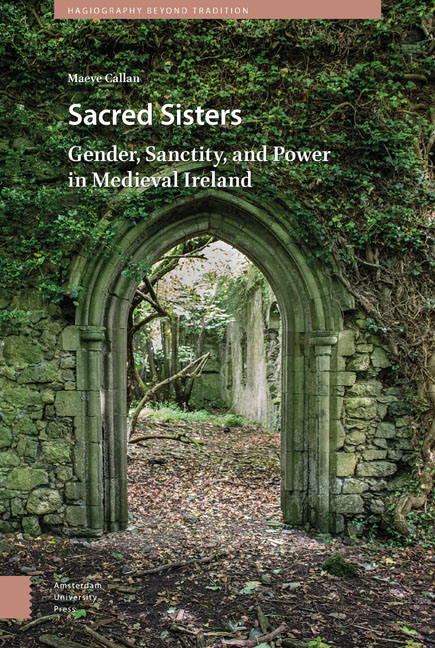Book contents
- Frontmatter
- Dedication
- Contents
- List of Figures
- Preface
- Introduction
- 1 “Founded upon the Rock Which is Christ”: What Patrick and His Promoters Reveal about Women in the Early Irish Church
- 2 “A New and Apostolic Band of Virgins Arose”: Darerca, an Exceptionally Learned Abbess
- 3 “The Safest City of Refuge”: Brigid the Bishop
- 4 “God is Always Present with Those who Exemplify Such Devotion”: Íte, Foster-Mother of the Saints of Ireland
- 5 “Do not Harass my Sisters”: Samthann, an Abbess not to be Crossed
- 6 “I Place Myself under the Protection of the Virgins all Together”: Sister Saints with Something Like a Life
- Conclusion
- Appendices
- Appendix A The Sites
- Appendix B The Sources
- Appendix C Feast Days of Early Medieval Irish Female Saints
- Appendix D Glossary
- Appendix E Pronunciation of Personal Names
- Bibliography
- Index
3 - “The Safest City of Refuge”: Brigid the Bishop
Published online by Cambridge University Press: 24 November 2020
- Frontmatter
- Dedication
- Contents
- List of Figures
- Preface
- Introduction
- 1 “Founded upon the Rock Which is Christ”: What Patrick and His Promoters Reveal about Women in the Early Irish Church
- 2 “A New and Apostolic Band of Virgins Arose”: Darerca, an Exceptionally Learned Abbess
- 3 “The Safest City of Refuge”: Brigid the Bishop
- 4 “God is Always Present with Those who Exemplify Such Devotion”: Íte, Foster-Mother of the Saints of Ireland
- 5 “Do not Harass my Sisters”: Samthann, an Abbess not to be Crossed
- 6 “I Place Myself under the Protection of the Virgins all Together”: Sister Saints with Something Like a Life
- Conclusion
- Appendices
- Appendix A The Sites
- Appendix B The Sources
- Appendix C Feast Days of Early Medieval Irish Female Saints
- Appendix D Glossary
- Appendix E Pronunciation of Personal Names
- Bibliography
- Index
Summary
Abstract
Brigid, Ireland's only female patron saint, reveals relationships between Ireland's indigenous traditions and its adopted Christianity as well as the power and authority available to at least some women up until the twelfth century, a time of seismic change for the island. Multiple medieval sources insist she was ordained as a bishop, a status that her successors as abbess of Kildare shared until Ireland's ecclesiastical hierarchy was drastically revised in 1152. Several sources also show her performing a miraculous abortion for a grateful nun, a miracle several other Irish saints, all male, are recorded as performing as well, challenging conventional assumptions about Catholic sexual morality. Her status as most beloved of all Irish saints in the Middle Ages is attested throughout western Europe; despite this great devotion, or perhaps because of it, Brigid's historicity remains elusive. Her cult is steeped in conflicting claims of competing political factions, and each locality of her devotion stamped her image with its own mark. In addition, her cult has been influenced by the cult of the Goddess Brigid. Some have rejected the saint's historical existence entirely, seeing her purely as an euhemerized deity, a Goddess made mortal but without incarnation—a textual, archaeological, and ideological translation from one faith (Paganism) to another (Christianity). Though such a position is not entirely unwarranted, it seems more likely that the cult grew around an actual fifth- and/or sixth-century woman who dedicated her life to God, exemplified exceptional charity and devotion, and established religious communities and churches. Or she may not have been only one woman, but a composite character who incorporated the attributes and accomplishments of several early Christian women, as well as those of indigenous Goddesses and Mary, the Jewish mother of Christ. Whether she was more Goddess than woman, one woman or several, Brigid was a preeminent Christian saint, representing to the Irish important truths about what it meant to be Christian as well as representing virtues of the Irish themselves.
Key words: female ordination, double monasteries, abortion, paganism, Syncretism
Twenty-seven saints gathered at the future site of Kildare when Brigid was a girl. At a nearby nun's request, Brigid went to address their assembly.
- Type
- Chapter
- Information
- Sacred SistersGender, Sanctity, and Power in Medieval Ireland, pp. 85 - 112Publisher: Amsterdam University PressPrint publication year: 2019



